Thursday, December 28
Bragging Time
I obtained a copy of THE CHURCH VISIBLE... for $3.
Usually, people feel honored for the opportunity to pay $80. Amazon.com lists one copy for $500.
I am quite pleased.
Remarks on a New Chapel, Sacred Heart University, Conneticut

Whether or not one accepts the necessity of a more traditional and organic approach to church architecture, it is easy to recognize that the architectural mainstream has moved beyond Corbu and his offspring, into the tangled waters of post-modernism, deconstructivism and various regional schools, in addition to the varying gradations of classicism and traditionalism.

There are some signs of hope. The floorplan is, at least, not in the round, and some effort has been made towards iconography. The college has hired the artist of the Redemptoris Mater chapel in the Vatican to provide designs for the project. Unfortunately, while the photos of his work in situ in Rome struck me as somewhat impressive, up close they are rather crude imitations of Byzantine work, and neither terribly original nor imbibing of the spirit which they seek to imitate.

What is frustrating in this design is not just its modernism--it is not aggressively ugly, but strangely anonymous. The campus is largely modernist in design, and one can make an argument that a chapel on site would have to find at least some stylistic common ground with its surroundings. But even if modernism of some stripe was called for, it still could have been interesting, if done with an eye towards coherent, clear volumes and liturgical hierarchy rather than the slanted, faintly squashed silhoutette that the chapel displays against the sky and the run-of-the-mill, umemphasized island altar on the inside. Like much work being done today, it looks like modernism on autopilot, done without much concern about the problematic philosophical convictions behind the style. Perhaps I misjudge the architect's intentions, but I can only go on what I can see here.

I think that if we are to get anywhere regarding the future of Catholic architecture, dioceses, universities and parishes who undertake such projects should consider holding competitions rather than simply handing out the commission from the start. Such competitions would allow younger architects in other parts of the country to become known on a national stage. If only they'd thought to do that at Sacred Heart, they might have produced something truly new and original, but firmly anchored in tradition, rather than being neither novel nor particularly beautiful.
Sunday, December 24
Merry Christmas

Hail and blessed
be the hour and the moment
in which the Son of God was born
of the most pure Virgin Mary
at midnight
in Bethlehem
in piercing cold.
Roast Pig at Christmas
So we decided to consolidate things a bit this year, leave the turkey and dressing for Thanksgiving and do the pig this year. Since the real Cuban Christmas dinner is usually held in the wee hours of Christmas morning after Midnight Mass, we decided that our former custom of having it on Christmas eve was really more of a chronological accident and are planning to do it Christmas Day.
And we're, pardon the awful pun, going whole hog this time. Literally. Cubans--and the Spanish before them--have always loved pork. You can tell where the conquistadores camped based on the big piles of pig bones they left behind. So, we'll be roasting a whole pig tomorrow, and it will either be incredibly good or a disaster. We've even got a special Cuban pig roaster, la caja china, the so-called Chinese box. If anyone is offended, it's not my fault--that's what they call it, and let me remind you that there are worse things than grills to have named in your honor, e.g., the Paddy Wagon. (And I'm part Irish too, so I'm allowed to make jokes like that.)
In any case, it will be an adventure. Expect photos and commentary, presuming we don't burn the house down in the process. In the mean time, a blessed Christmas eve to all, and to pass the time, why not read about the winner of the annual Fat Pig category at the Shropshine Agricultural Show, the infamous Empress of Blandings?
Or better, go hang out with your family - it's Christmas! Why are you surfing the web?
Saturday, December 23
Happy Feast of Adam and Eve
This feast is precisely, in fact, the reason that we hang apples on Christmas trees and have Christmas cookies. Originally, the un-adorned tree was put up in preparation for the feast of Adam and Eve. Only apples, representing the food which brought mankind death, and waffers, representing the Food which brings mankind Life, would be hung on the tree during the day of the feast. During the day, plays recounting the story of the fall would be acted out before the tree.
Of course, come evening, the tree would be decorated for tomorrow morn.
The Feast of Adam and Eve is also the source of my own favorite Advent hymn. Here is the text--and, if I can recommend it, look up the tune on iTunes. It's worth it.
Remember, O Thou Man
1. Remember, O thou man,
O thou man, O thou man,
Remember O thou man,
Thy time is spent.
2. Remember, O thou man,
How thou art dead and gone,
And I did what I can:
Therefore repent!
3. Remember Adam's fall,
O thou man, O thou man!
Remember Adam's fall
From heaven to hell!
4. Remember Adam's fall,
How we were condemned all
To hell perpetual,
There for to dwell.
5. Remember God's goodness,
O thou man, O thou man!
Remember God's goodness,
And promise made!
6. Remember God's goodness,
How His only Son He sent
Our sins for to redress,
Be not afraid.
My roommate will tell you that this song is particularly poignant when played, repeatedly, the week of finals--Thy time is spent!
Any priest, by the way, who makes mention of the feast of Adam and Eve at Saturday morning mass tomorrow is hereby awesome latea sententiaea. But if any one actually sings this, the most appropriate hymn for the day (we sang it at a lessons and carols I attended a few weeks ago, actually), I will personally send them a recognition of their awesomeness, if you drop me a note.
Friday, December 22
Bastogne - December 22, 1944
The fortune of war is changing. This time the U.S.A. forces in and near Bastogne have been encircled by strong German armored units. More German armored units have crossed the river Our near Ortheuville, have taken Marche and reached St. Hubert by passing through Hompre-Sibret-Tillet. Libramont is in German hands.
There is only one possibility to save the encircled U.S.A. troops from total annihilation: that is the honorable surrender of the encircled town. In order to think it over a term of two hours will be granted beginning with the presentation of this note.
If this proposal should be rejected one German Artillery Corps and six heavy A. A. Battalions are ready to annihilate the U.S.A. troops in and near Bastogne. The order for firing will be given immediately after this two hours' term.
All the serious civilian losses caused by this artillery fire would not correspond with the well known American humanity.
~The German Commander.
To the German Commander:
Nuts!
~The American Commander.
Incidentally, the arms of Bastogne include Our Lady and Our Lord.

A shot of a rare, and much-coveted, Cardinalatial Bingo set commissioned late in the reign of John Paul II.
Actually, for what it really is, go check out our Roman friend Zadok.
The Borromini Girl
...in despair I took the sword and pulling it out of the scabbard leant the hilt on the bed and put the point to my side and then fell on it with such force that it ran into my body, from one side to the other, and in falling on the sword I fell on to the floor [...] and because of my wound I began to scream, and so Francesco ran in and opened the window, through which light was coming, and found me lying on the floor, and he with others whom he had called pulled the sword out of my side and put me on the bed; and this is how I came to be wounded.
--Francesco Borromini: From an Account of his Successful Suicide Attept, 2 August 1667
When we entered, a merry maelstrom of studious noise
Full of commonplace bodies,
She was there,
Standing isolated in the center of the colonnade
Of this palace of lacy rain and mildew,
La Sapienza—wisdom,the wisdom of a university
And a universe. Once a college, now an archive:
Wisdom robed in musty cracked sienna stucco.
Wisdom has set up his seven pillars,
In this urban wilderness.
Grass grew parasitically
Between the coal-black pavement stones.
(And I heard a distant voice breathe, and cry: O Sapientia!)
She continued to draw, oblivious to us and all others.
I knew not her language or name.
She was cool and quiet as a classical column,
Standing there in the pale damp gothic light
Of a Roman drizzle, a perfect sentient counterpoint
To the weird suicidal snail shell of the Borromini
Church’s baroque lantern,
A glorious monument to self-destructive genius,
A flaming crown for a momentary phoenix of invention.
And whanne Sche hadde herd, Sche was troublid in his word,
And thouyte what maner salutacioun this was.
(They say it means charity, wisdom,
The perfect Platonic
Perfection of the sphere, the ball, suspended over the
Rayonnant crown of burning charity:
And the cross above that with the dove of the
Holy Ghost—but we were told not to draw
The brass summit-cruciform,
Lest this baroque-gothic monstrum seem
Less than weightless
By its Sacrifice).
Did she know, this serene virgin,
In rumpled brown corduroy trousers and a sky-blue parka
That matched her pale sapient eyes, far more vivid
Than the empty sky overhead,
Did she know that the tortured architect of this place
Had killed himself, leaving this one of
A dozen unhallowed tombstones?
Borromini hath fallen on his sword.
Borromini hath fallen by his own sword.
And cut himself body from soul.
(And a voice cried: O Adonai!)
No—or perhaps she had looked beyond the blood stained
Across the snow-white stucco, looking
With an intent crook of a dark eyebrow,
With a bowed head framed by a tumbledown lock
Of her bobbed gold-brown hair
With an intent purse of her pink, untinted, elemental lips—
Lips like those that said, in Nazareth,
Two millennia ago: Fiat voluntas tua—
With her neck craning forward with vague eyes
With those eyes growing wide
As if she had just seen the whole
Of the Universe, and
As if to hear the music of the building
And the very music of the Spheres—
And the voice cried: O Radix Iesse!
—With all these, with this careful drawing
And attention
And placid serene attention
She birthed the building anew
In my mind, a monument
Not to uncontrollable genius,
Not to self-slaughter and dismal overgrown despair,
A whitened sepulchre
Full of stony funereal torches crowning its highest pinnacles:
But instead it became incarnate blinding whiteness,
A lobed dome like the mind of God, with colorless color
Like the wing of a seagull
Perched atop one round-balled finial in the dismal sky.
Like the wing of the Dove.
And the voice from heaven cried: O Clavis David!
She hesitates—
And Marie seide to the aungel,
On what maner schal this thing be doon,
For Y knowe not man?
—she hesitates, and there is, as she shifts her weight,
A sharp balletic movement as she thrusts out one leg,
A stamping of feet like a foal pawing the earth.
Perfectly commonplace as she is a commonplace girl,
With a pretty, anonymous profile.
She sketches, intently, bending close to her page,
Impossibly close, like a monk in a scriptorium.
A shy scratch,
A deep breath,
A symmetrical parting of her
Drooping gilt locks.
The shy downward turn of her head like a Bernini angel,
A glimpse over one shoulder.
The wind flickers through her hair—O Oriens!
O Rex Gentium!
And the rain spirals out through drainpipes like Solomonic columns.
I am mad with damp cold, and have lost my coat.
And she bows profoundly, stiff-backed,
Stretching and placing her work at her feet
As if to study it
But it seems more as if she is honoring, with a sacred gesture
Those creedal words, et incarnatus est.
And Elizabeth was fulfillid with the Hooli Goost, and criede with a greet vois,
And seide, Blessid be Thou among wymmen,
And blessid be the Fruyt of Thi wombe.
And the monument is clean and new,
Freed from debt and ghost of suicide,
And the cross is bright in the newly-fired morning sun.
O Emmanuel.
And the voice cried again, from the the womb:
Tomorrow I shall be.
For God’s providence and God’s charity, and God’s wisdom, is wondrous.
I looked for her again later, and she had gone.
Francesco Borromini of Ticino, master architect and Knight of the Order of Christ, died of his wounds, in his right mind and with the consolations of the Church, on the third of August in the year of Grace 1667. Pray for his soul.
Thursday, December 21
Humbled
Christ the King!
Though I'm almost certain the EU would never allow it, it would be even more POD than St. Anthony's post-mortem stint of military service in Spain.
Last Minute Christmas Ideas?
Wednesday, December 20
Good Catholic Architecture Comes to Long Island
Our hope is that this nobly simple Chapel will be a profound inspiration for our faculty and students. Iconography and other art will be Franciscan and where possible Umbrian.
I hope that you will share the excitement found in growth. Know that any inconveniences we experience will be fleeting compared to the lasting beauty of this Chapel.
Truly an inspired design, and an encouraging sign for the future. The use of the ideal of "noble simplicity" in a correct rather than iconoclastic way is also very encouraging. Hopefully more high schools with dated 60's buildings and chapels (like St. Anthony's has at present) will take the initiative and center their fundraising campaigns on the important things. For that matter, hopefully more parishes will realize that good church architecture can be realized without completely breaking the bank.
The End of Tower Records and the Exaltation of "You"
In the same week as the closing of Tower, Time, as Drew has pointed out, named "You" its "Person of the Year," a selection stunning in its banality and its unofficial declaration of the irrelevance of traditional print media in this form. In a sense these two events are very closely connected, since the Internet and its media options that exalted "You" are precisely what have forced the closure of a place like Tower Records. The problem at the heart of all of this is individualism, the individual choice trumping the formation of community, and it is ultimately poisonous and dehumanizing. This is a very troubling proposition, and not only because it closes record stores (Tower Records, of course, was no paragon of Catholic values or morality, and my purpose here is not to defend it absolutely, but to offer it as an example of where the exaltation of "you" leads).
The larger problem is that the exaltation of "you" becomes the exaltation of me, of my wants over and against those of a broader community. There is one sense in which the increasing fragmentation of postmodern American culture can be an opportunity to realize that the "American century" as exemplified by the seeming peace of the '50's never really was all it was cracked up to be, but the dark side of this fragmentation is turning inward, without a sustaining community. This is the way to loneliness and darkness, individuals in front of computer terminals perhaps talking to one another in some way but not really encountering one another.
How can we as a Church, then, respond to this fragmentation and loneliness of the exaltation of "you" and individualism? Not, first and foremost, by giving in and becoming part of it, by becoming a consumer-oriented Church. Rather, our call is to find love and community in the joy of the encounter with Jesus Christ, through beauty, goodness, and truth. Instead of being consumers, this kind of an approach leads us to be precisely the ones consumed, taken over and transformed by the love of Christ, which indeed is a consuming fire as the prophet Malachi reminds us. Only in this way can we provide a prophetic witness in a culture that offers us ever more personal choice, but in so doing often just offers us different ways of becoming lonely and fragmented. It is the unity of the love of Christ that turns consumerism upside down and enables us to live lives of holiness in community with one another, with the saints, and with God.
Excellent Article

Father Balthasar, you've just won Theology Bowl MVP. What are you doing now?
I'm going to Disneyland!
In reading sections of Aidan Nichols' new book Scattering the Seed, I discovered an article that Balthasar wrote in 1939 called "The Fathers, the Scholastics, and Ourselves". This article is excellent in many ways, most notably for the way it challenges (successfully, I think) the Ressourcement to take Scholasticism seriously by critiquing tendencies towards a romantic exaltation of the Fathers over and against later theology. The impact of this critique can be seen most especially in de Lubac's work on the supernatural, where he goes precisely into a rigorous study of Scholastic thinkers in order to critique and undermine certain positions taken by later Scholasticism.
Balthasar also, I think, proposes an intelligent way forward for integrating the knowledge of the past into the theology of the present and future without being either iconoclastic or idolatrous with respect to that past. This is one area, I think, where Catholics have been especially ill-served by many of the mainstream "liberal" and "conservative" positions since the Second Vatican Council. On the one hand, there was an embrace of novelty that failed to adequately integrate the tradition, and indeed saw this tradition as being dead in the water. On the other, there was a tendency to cling to a triumphal view of Scholasticism, in which theology had essentially found its culmination in the works of Thomas Aquinas, and indeed in a certain reading of Thomas Aquinas that tended towards emphasizing the Aristotelian aspect of his work. The general arc of this line tended to emphasize the notion that Scholasticism was more or less common sense, and that anything after was a turn away from this golden mean. This kind of story arc tended first of all to ignore the very complicated nature of thought in the Middle Ages (and indeed the Augustinian and Dionysian aspects of Thomas' thought), and the fact that Aristotelian logic and science are not infallible guides.
Neither of these solutions was particularly helpful for healthy theological development in the Church, and it was precisely thinkers like Balthasar, de Lubac, and Etienne Gilson (with his return to the "historical Thomas Aquinas") who helped to bring about a new and better synthesis. This hard work, which often met strong opposition from both extremes (and indeed still does in some cases), now bears its fruit in the theological vision of Benedict XVI, which spurns neither Scholasticism nor modern theological developments, but takes, as Balthasar did, the approach of St. Paul: "Test everything, hold fast to what is good." (Also, incidentally, the title of an excellent book-length interview of Balthasar conducted by Angelo (now Cardinal) Scola).
Toledo Cathedral -- No, the Other One

An intelligent and distinctly non-derivative take on Gothic.

Towards the sanctuary.

The coronation of Mary depicted in the conch of the apse - a splendid fusion of twentieth-century innovation and Byzantine traditions.
Tuesday, December 19
Dappled Things - Advent/Christmas Edition
Incidentally, the magazine is accepting new pieces for the Lent/Easter 2007 edition; the submission deadline is February 4, so get those pens to scratching!
Monday, December 18
Benefits of Latin
Quem mihi dabis, qui aliquod pretium tempori ponat, qui diem aestimet, qui intellegat se cotidie mori? In hoc enim fallimur, quod mortem prospicimus: magna pars eius iam praeterit; quidquid aetatis retro est mors tenet. Fac ergo, mi Lucili, quod facere te scribis, omnes horas conplectere.
Sunday, December 17

The Holy Father with the set, and... [His Eminence Tarcisio Card.] Bertone spikes the ball! The Vatican wins!!"
Approving Truth Where Found
Thus Augustine:
God has determined that in the case of every schismatic and heretic, the wound which caused his separation should be cured by the medicine of the Church; but that what remained sound in him should rather be recognized with approbation, then wounded by condemnation. (On Baptism, Against the Donatists; I.7)
And that is why we rightly call Christians outside the Catholic Church "separated brethren," because we do not condemn what they rightly believe about Christ, and can only respect them for what they rightly believe in Christ, and call them to believe it with us.
Huzzah!
Friday, December 15
Notre Dame School of Architecture Update
Thursday, December 14
From the "You Can't Make This Stuff Up" file...
The Great Nativity Scene Search, Part 1
At Bombay Company, Monday.
Christmas decorations everywhere--angels of all kinds and sorts, Christmas balls, more angels, even a decorative cross for some baffling reason on the back shelf. And have we mentioned the angels?
Me: Do you have a creche?
Saleswoman: Ummm. I don't think so. Let me go ask.
(She disappears into the store-room and there is much banging and some shouting, and she pops in and out of several doors and consults at least one other.)
Saleswoman: (To yet another person) Do we have what he wants?
(Blank stares)
Me: A creche?
Saleswoman: I don't think we do.
(I discover two in the store before I leave, one of which is too cutesy Martha Stewart and the other is massive, histrionically Neapolitan and $150).
At Pier 1, Monday.
More abstract Christmassy things. Lots of crystal balls and semi-tropical dried tree stuff. And mass-produced Buddha heads.
Me: Do you have Nativity scenes?
(Matt sincerely hopes the saleslady isn't going to advise him to go the movie theater next door to ask for promotional materials for the new Christmas movie.)
Saleslady: What?
Me: Nativity scenes.
(Blank stare)
You know, creches.
(Blank stare)
The ones with the mangers?
(Matt begins to resort to hand gestures, and briefly considers throwing in a reference to the sixth age of mankind, the whole world being at peace, in Bethlehem of Judaea and all that... But does not, as he does not want to be taken to Bellevue.)
Saleslady: Oh, those, with the shepherds and all that stuff.
Me: (Brightening). Yeah, nativity scenes.
Saleslady: We don't have those.
At Pottery Barn, Wednesday.
Lots and lots of reindeer. Reindeer candelabras. Christmas trees, with reindeer ornaments. And candles, the fat New Agey kind.
Me: (Trying a different approach, to give a little context--and to remind them what I want is related to Christmas). So, uh, I see you've got a lot of Christmas decorations here. How about nativity scenes?
Salesman: Oh yes. Sorry, we don't actually have those.
And the search continues...
The Infant of Prague
Matt: (suddenly realizes he doesn't really know much about the devotion, that it's just always sort of been there like a large bit of Victorian furniture in a small room that he's very used to but doesn't think much about) Well, uh, I think there was a statue of Christ in Prague, and, um, a devotion grew up around it. Maybe some miracles. I really should know more.
Dawn: Oh, okay.
Matt: He appears to have gotten a lot of really weird outfits from people, too as gifts. The crown, the big triangular robe...
Dawn: I was wondering about those.
Matt: The one thing I really know about Him besides that He's popular on holographic holy cards that change colors when you look at them the right way, is there's a joke that Mary saw Our Lord walking out the front door in the Infant of Prague outfit, and she said, "You're not going outside dressed like that!"
My favorite Infant of Prague joke actually refers to a priest who told me about a fellow clerical friend of his showed up to co-preside at an interfaith wedding and decided to really show the flag by going, as he put it jokingly, "dressed as the Infant of Prague," i.e., biretta, cassock, stole, lace surplice, and "a cope so heavily embroidered it stood up by itself..." I think the minister felt a little underdressed in his choirrobe.
Good times, good times.
Wednesday, December 13
Hi Bob
Jerry: Howard wants pizza.
Howard: No, I don’t. I want some Moo Goo Gai Pan.
Bob: (Into phone) Did you hear what Howard wants? Oh. Moo Goo Gai Pan.
Jerry: That’s what I want, too. Dr. Jerry Robinson wants Moo Goo Gai Pan.
Bob: (Into phone) And more Moo Goo Goo Goo.
Jerry: Did you hear what you said, Bob? You said, "more Moo Goo Goo Goo." You said "Moo Goo Goo Goo."
Howard: That’s right. You said "Moo Goo Goo Goo."
Bob: Maybe I’m ordering Chinese baby food.
Still Alive
Monday, December 11
In other news, body of famed Union General discovered in Grant's Tomb. Authorities baffled.
East Liberty Presbyterian Church, Pittsburgh
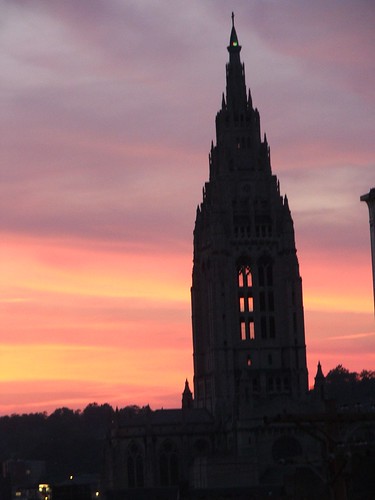
The tower, in profile.
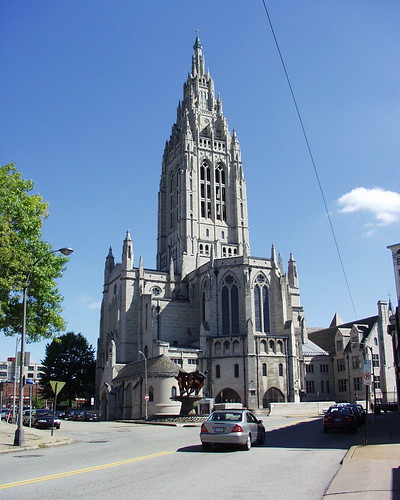
The central crossing-tower and apse.
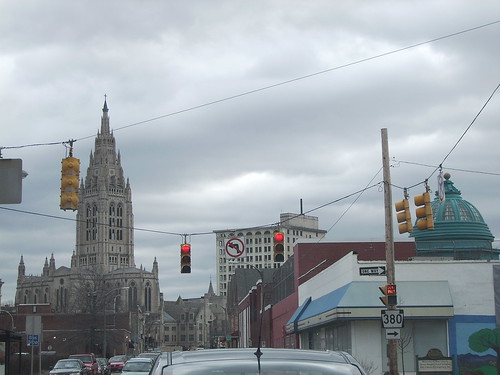
The urban context

The front facade

Some aspects of the front portal appear almost Hispano-Moorish (or Mudejar), adding to the subtle exoticism of the design
The exact significance of crossing-towers in church architecture is varied; there are numerous English and Continental Gothic examples, and their classical equivalent, the dome or lantern, is ubiquitous in Renaissance and Baroque designs. In some late nineteenth and early twentieth century instances, a large central crossing-tower can be connected with a church designed for preaching allowing to pack as many people as possible into hearing-distance of the pulpit; however, given the surprisingly conventional and even quasi-Catholic layout of the interior, I would suppose this was less a political choice than at the original design of St. John the Divine and St. Bart's, Park Avenue. Here, it gives considerable prominence to the church in its urban setting in a way that simple facade-towers would probably not have.

The chancel at Christmas.
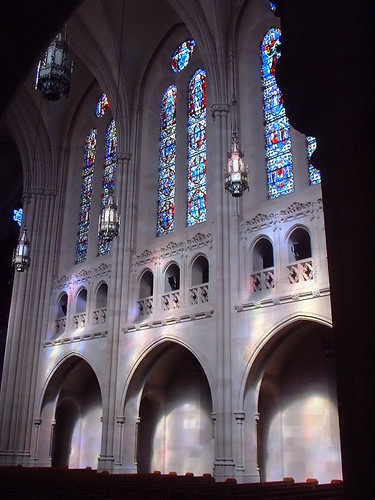
A side-aisle.
In this view of the side-aisle, the abstract simplified elements that characterized Cram's later career are mixed with moments of high detail. This contrast is especially evident in the plain, untraceried rose windows overhead, which demonstrate what one critic has referred to as Cram's aesthetic use of "negative space." In the interior, it's quite striking, though the porthole-like appearance on the exterior is slightly odd.
Cram once said, in view of the building's surprisingly traditional liturgical layout and iconographic program, that all that needed to be done to make the sanctuary ready for a Catholic High Mass were six candles, a crucifix and twenty minutes of prep time. I'm told that a Catholic priest once was taking a tour of the premises and was directed to a window depicting the Apocalypse with a prominent image of the Woman Clothed with the Sun. "That," said the tourguide, "is the Queen of Heaven."
"Ah, the Virgin Mary," said the priest.
"No, we're not Catholics, it's the Queen of Heaven."
"Welllll, who's the Queen of Heaven then?"
The tourguide didn't know.
Maybe he should take those twenty minutes.
Viva la Counter-Reformaccion?*
From Zenit:
Mexico is seeing a veritable boom in vocations to the priesthood and religious life, says an official of Aid to the Church in Need.
"There are about 12,000 young men preparing for the priesthood in Mexican major seminaries, while 15,000 active priests are serving the faithful," said Xavier Legorreta, head of Aid to the Church in Need's Latin America I section.
The article says that Mexico is one of the two countries sending the most missionaries abroad. That's good--but I hope a lot of them stay home, too.
*It's almost Spanish...
Sunday, December 10
Once Again, Matt Wants You To Remember He Will Be On the Radio Tomorrow

A statue of late Pope John Paul II stands over the people who gathered for the inauguration of the artwork Sunday, Dec. 10, 2006, in Ploermel, western France. The giant statue was made by controversial Russian artist Zurab Tsereteli, President of the Russian Fine Arts and is a gift from the artist to his friend, the mayor of Ploermel, Paul Anselin.
Source.
Workers' Mass
I firmly believe that a number of people in your congregations would go to daily Mass, and that you can take steps to do this. I believe it because of my experience at my parish.
My parish is about 300 families, I would estimate. We have a daily Mass attendance of about 80 people; during Advent and Lent, over 100.
Father’s approach is very simple: enable almost anyone with a job to be able to attend this Mass. Mass begins every day at 7:00am, sharp, with two verses of a hymn played by the organist. There is no homily. By 7:08, Father begins the ordinary of the Mass. By 7:17, I have received communion. At 7:21, the Mass is over with another two verses of a hymn. Perhaps a dozen people stay for a long time to pray; the rest mingle or head to work.
Father is, deservedly, pleased, I think, with the attendance at daily Mass. He suggests attending daily Mass from the pulpit on Sundays, particularly before Lent. People hear him, and people come.
This is very easy, yet it avoids so many, many, many pitfalls which the celebration of daily Mass so often suffers.
(1) Impossible Time. Most daily Masses seem to take place after 8am, which rules out the majority of professional works from attending.
(2) Irregular Time/Place. Parishes almost always move their daily Masses around, having one here at this time and another there at that time. Perhaps the idea is to get more people to come? Yet, all it does is prevent people from making that Mass a regular part of the daily routine. "Is Mass today? Where? When? Oh, whatever, I’m late."
(3) Inconsiderate Length. I have attended daily Mass in the morning and seen priests preach for 15 minutes. No joke. You can see the employees turn red and rap their knuckles, the parents turn jittery, etc. There is no need to preach a reflection beyond a few sentences, if that. We all know why the people are here at 7am on a Tuesday: the Blessed Sacrament.
(4) Funkiness. Often, it seems, celebrants want to jazz up a daily Mass somehow or another, opting not to use this vestment or to break that rubric, as if to compensate for the low-key nature of a daily Mass by making it different or more interesting. And yet, we spend time with our friends every day precisely because we know who they are and like the time we have with them. Spending time with Jesus, similarly, is not dependent on how unpredictable that time is.
I can only give two answers to these concerns that so often prevent Mass from being a simple, quick, and no-frills daily routine: first, the fact that people, in my small parish, flock to it; second, the following reflection from Card. Newman on why a quick, no-frills Mass is not only defensible, but deeply beautiful:
To me, nothing is so consoling, so piercing, so thrilling, so overcoming, as the Mass, said as it is among us. I could attend Mass for ever, and not be tired. It is not a mere form of worlds,--it is a great action, the greatest action that can be on earth…. [The Eternal] becomes present on the altar in flesh and blood, before whom angels bow and devils tremble… Words are necessary, but as means, not ends… they are instruments… of consecration, of sacrifice. They hurry on as if impatient to fulfill their mission. Quickly they go, the whole is quick; for they are all parts of one integral action… Quickly they pass; because as the lightening which shineth from one part of the heaven unto the other, so is the coming of the Son of Man… Each in his place, with his own intention, with his own prayers, separate but concordant, watching what is going on, watching it progress, uniting in its consummation… There are little children there, and old men, simple laborers, and students… but out of these many minds rises one Eucharistic hymn!
--Card. Newman, Loss and Gain, part ii, chapt. xx.
Saturday, December 9
Once Again, Matt Wants You To Remember He Will Be On the Radio Monday
(Emergency! Everybody to get from street!)
Friday, December 8
Princeton Chapel

The chapel exterior.

A mannered interior. Unfortunately the altar is treated witha certain aesthetic and sacramental timidity.

A detail of the pinnacle. Treating the element as a turret with windows is the sort of understated innovation typical to Cram's work.

Another view.
Overall, the design is elegant and workmanlike, if not as excitingly rugged as his work at St. John the Divine or as cleverly responsive to its surroundings as St. Thomas, Fifth Avenue. I have never been there, so perhaps the more unique aspects of the design are not apparent in photographs. A stranger aspect is I recall that some of the windows have a distinctly literary bent--The Divine Comedy and Pilgrim's Progress rather than more a more liturgically coherent program, and which suggests the notion of the chapel as a piece of symbolic campus furniture than a truly sacramental center. Indeed, the principal weak point of the design--a certain mechanical feeling in terms of the combination of its parts--seems to be the result of the problems inherent in building a college chapel at what must have even then been a campus that was essentially secular.

Who couldn't love our Holy Father...??
Matt Talks Liturgical Architecture on the Radio Monday
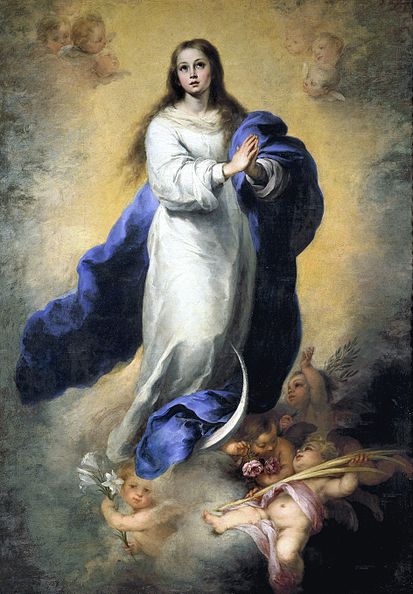
Wednesday, December 6
I've been wishing someone would do this for a long time...
NB: You can listen without downloading the player, just select "other player" and it will open up in whatever you have set as your default. The playlist opens in a separate window.
Tuesday, December 5
Hey, my drawing's on National Review Online!
We want YOU for the Liturgical Police!
My 4th grade daughter noticed during the uber-folksy "Glory to God" (with clapping) that her MagnifiKids said that this prayer/hymn is not said during Advent. I actually did not know this. After Mass, I suggested she show this to the priest, which she timidly did. The priest responded by laughing and calling her the "liturgical police" and then asked her "What's the difference between terrorists and liturgical police? You can negotiate with terrorists." Then sensing comparisons between 4th grade girls and murderers might not be very pastoral, laughed and said "I'm going to report you to the pope for doing a good deed." Nice.The priest, of course gets it wrong. You can't negotiate, not with the liturgy police, but with a liturgist, a very different animal indeed.
Which makes me think, perhaps the CDW should set up a Black Ops Division. I'm imagining black-cassocked priests in mirror-shades swarming over a 1970s-style church. And then the bullhorn sounds: "STEP BACK FROM THE TAMBOURINE AND COME OUT WITH YOUR HANDS UP! WE HAVE YOU SURROUNDED AND AUTHORIZED TO USE THE THURIBLE IF YOU DO NOT COMPLY!"
More Dawn
Two Minutes to a More Pro-Life World
We all know that medicine belongs in babies, babies don't belong in medicine!
So the FDA has recently opened a forum in which consumers and medical professionals can voice their opposition to the use of aborted fetal and embryonic cell lines in vaccines. Some common ones that currently use these cells are chicken pox and rubella. This forum expires on December 28th, 2006.
Click HERE for a link that takes you through the process of e-mailing both the FDA and the CDC.
The forum expires DECEMBER 28th, 2006.
Please, pass it along!
Monday, December 4
Random Thought

The lovely and talented Dawn Eden, author of The Thrill of the Chaste, looks to have an exciting few weeks ahead of her as her magnum opus hits the bookstalls. She'll be doing an inaugural book-signing at Borders Books and Music, Kips Bay Plaza, 576 Second Ave. (32nd St.), Manhattan, 7 p.m. Thursday, and then virtually all over creation the week after that. (For a full list of appearances, check here.)
Please support Dawn and her new book; it's going to take chastity to a whole new audience of young urban women who might not get a shot at hearing the Gospel otherwise. The audience currently getting the Theology of the Body is overwhealmingly college-aged and often already at least nominally Catholic: however, Dawn has chosen the tricky task of simultaneously preaching to the heathen and the choir, and therein lies her strength. Plus, it's got a cover that I don't think will embarass anyone, male or female, if they're caught reading it on the subway. (Let's be honest here: the purple cover of Good News about Sex and Marriage is a little freaky, no offense, Mr. West. It's great otherwise, though.) Anyway, keep her in your prayers, and if you're in Manhattan, show the flag this coming Thursday!
Let us attend!
Exclusive interview of Patriarch Bartholomeus with the semi-official daily of the Italian Episcopal Conference, Avvenire:
Thus Rorate Caeli:
Reporter: This morning's speeches and the joint declaration that you have undersigned sounded "lofty" and certainly promising. You have even spoken of the future, regarding the [future] steps?
Patriarch: Regarding this, I can say that I have spoken to His Holiness about something, something we can do. I have made him an offer that I cannot yet talk about, while we wait for an official response in this sense; however, I can say that His Holiness displayed great interest and welcomed the offer favorably. We hope that it can be accomplished, because it truly follows the prospects of that ecumenical progress which, as we have affirmed and even written in the Joint Declaration, we both are determined to pursue.
Sunday, December 3
More Liverpudliana
I'm not sure how the presumably conservative jurors took this rather idiosyncratic modern rendering of Gothic, but it is certainly worth of study. Mackintosh's work is rather more abstract than my tastes usually run, but he handled simplicity well, had a deep sense of humanizing craft, and the proto-modernism he practiced is one far more easy to reconcile in retrospect with traditional architectural orthodoxy than Gropius, Mies and faceless stack-a-prole Corbusianism. If you're going to have simplicity anyway, you'd do well to stick with Mackintosh.
Some details of this project appear to have influenced Scott in the final form of the cathedral as it was built, as the design evolved over his long life. (Incidentally, in the free time in between cathedral-building jaunts, he also found time to design the iconic British red telephone box, endowing the streamlined design with a neo-Georgian classicism inspired by Sir John Soane's work. However, some of his later work, like Our Lady of Mount Carmel, Kensington, is a bit of a mess.)




These images are © The Hunterian Museum and Art Gallery, University of Glasgow, 2006. If there are any protests, I will remove them. More of the cathedral designs can be found via their search engine.
Armenian Genocide
Saturday, December 2
While we're on the subject of flying turtle monsters...
Best Sidebar Ever?
Simple Minds, Simple Pleasures...
"The Congenial Pope"

With almost palpable annoyance, BBC concedes the Pope's trip to Turkey has been quite successful, though hides that news under a very banal headline:
Turkey's liberal newspaper Milliyet called it "The Istanbul Peace", while Vatan declared: "History Written in Istanbul."
Hurriyet, one of Turkey's most influential papers, called Benedict "the congenial pope".
The 79-year-old pontiff had paused during his tour of the famous mosque on Thursday, standing alongside the mufti of Istanbul, facing Mecca and adopting an attitude of Muslim prayer known as "the posture of tranquillity".
"It was something beautiful," said the mufti, Mustafa Cagrici.
...
The Pope also made a conciliatory gesture to Turkey by expressing support for its membership of the EU, reversing the opposition he voiced as a senior cardinal, when he said it would be "a grave error".
However he implied that respecting freedom of worship should be a condition for Turkey's entry.
No mention of WHY the Pontiff should mention religious freedom in Turkey, that is, no mention of the crippling oppression in which the Orthodox patriarchate dwells. But, then again, the BBC isn't run by nice people, anyway.
I think the trip was a success.
(1) The Pope survived, which honestly the whole world was nervous about--not without reason, considering this book was a best-seller prior to his arrival.
(2) The world knows, via the most successful PR compaign possible (if still not as successful as desirable), that life sucks for Turkish Christians and that the Patriarch has had his seminary close and his buildings confiscated.
(3) What no one really considered possible, that the Pope would get any positive Turkish press, has proved the case: at least among non-radical Muslims, he made a very favorable impression, without compromising what he believes: he advocated EU entrance "in accord with European values," which every paper knew meant religious freedom, but the most impressive thing he did was something which a religious leader does at all times and in all places: he prayed.
Well, praise God. Viva il papa!
Friday, December 1
Liverpool Anglican Cathedral
Some aspects--such as its rugged, even daunting chunkiness, rather suitable for a working-class town like Liverpool--date it incontestibly as a twentieth-century work; and yet, in quality of ornament it is the equal of anything produced in the Middle Ages. I'd like to post at greater length and leisure sometime in the next few weeks on the church's influence in later designs--just about any Gothic church built in the U.S. or America since was impacted by it in some way--and also about some of the odder aspects of its internal arrangement and their relationship to certain liberal and conservative transatlantic trends in the Episcopalianism of the time--and what Catholics can learn from them, both for good and for ill. Perhaps next week. Until that time, a few photos.

A view from the exterior. One of the more unusual aspects of the church is its massively oversized crossing and mammoth tower, featuring not one but two transepts. Scott's proposal originally included two facade towers and a rather strange side-elevation.

Looking towards the liturgical west end of the church, from the quire. The rather strange pulpitum that bridges the nave before the crossing is clearly visible. .
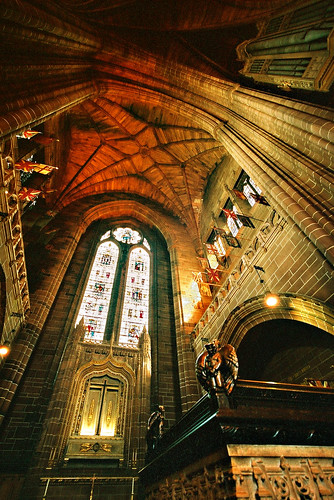
A side-altar.

Another view of the pulpitum, and its liturgically rather strange placement, bridging the nave rather than the entrance to the sanctuary.

A dramatic view of the westwerk.

The Lady Chapel.
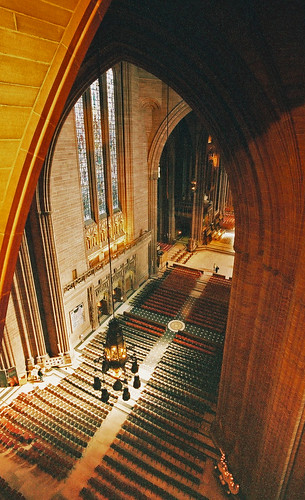
A view of the nave from on high.

Another view of the Lady Chapel, its phenominal quasi-Teutonic altarpiece shrouded with scaffolding, sadly. A better view can be found here.
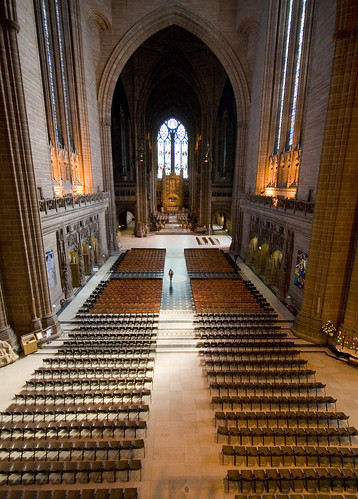
Towards the high altar. The combination of broadness and height to the nave makes it seem particularly daunting and almost disturbing, rather than the comparative intimacy one finds in the narrower naves of medieval cathedrals.
Most of these I found via Flickr, and kudos to the original photographers. A particularly good set can be found here. If anyone has any problems with me posting these, I will remove them.
Incidentally, while the present-day Liverpool Catholic Cathedral is pretty weird looking (it's been compared to a wig-wam), it does lend its basement to hosting the Liverpool Beer Festival ever February. Take from that what you will.















